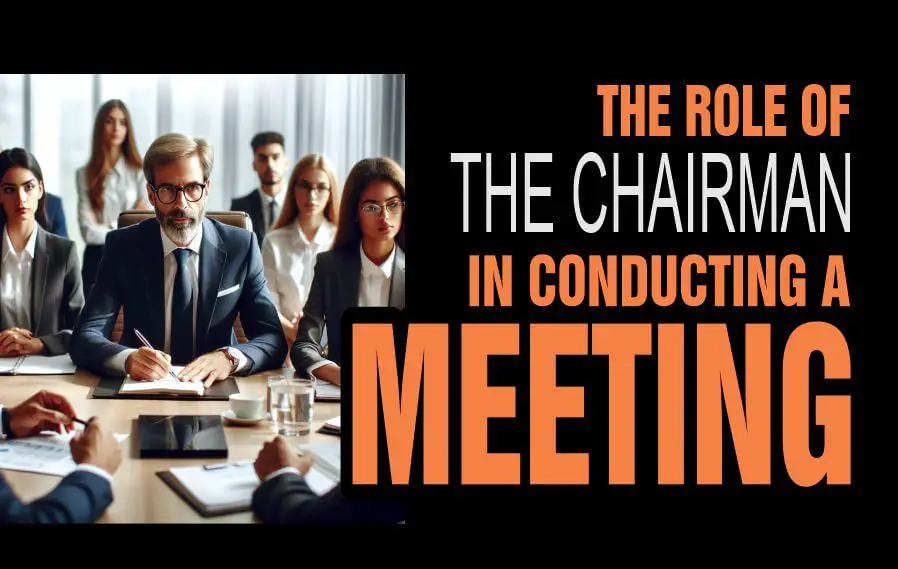Last updated on February 24th, 2025 at 11:48 pm
In any organisation or group, the role of the chairman is important in conducting effective meetings and making informed decisions.
While every participant plays a role, the chairman holds a pivotal position in ensuring that meetings run smoothly, efficiently, and within the guided framework.
This article aims to explore the duties of the chairman in conducting a meeting, highlighting the responsibilities they bear, the skills required, and the strategies they can employ for successful meeting management.
Table of Contents
- Qualities of a Good Chairman in Conducting a Meeting
- Understanding the Role of the Chairman
- Preparation before the Meeting
- Frequently Asked Questions
- Conclusion
Recommended: The Secretary’s Role at the Meeting
Qualities of a Good Chairman in Conducting a Meeting

Here are some qualities that make a chairman excellent at managing and leading meetings:
Preparation: A good chairman prepares well in advance by setting the agenda, gathering relevant information, and distributing it among the participants. They ensure that all necessary materials and resources are available before the meeting.
Leadership: The chairman should have strong leadership skills to guide the meeting and keep it on track. He sets the tone and provides clear directions, ensuring that everyone understands the purpose and objectives of the meeting. He can effectively delegate tasks and assign responsibilities to participants.
Related: Taking Meeting Notes the Right Way
Organization: A well-organized chairman manages the logistics of the meeting, including scheduling, venue selection, and coordination of participants. They ensure that the meeting starts and ends on time and keep track of the agenda to ensure all topics are covered.
Communication Skills: A good chairman is an active listener and an effective communicator. He encourages open and respectful participation, allowing everyone to express their views and opinions. They summarize and clarify discussions to enhance understanding and make sure that decisions and actions are clearly communicated to participants.
Facilitation: The chairman facilitates productive discussions and keeps the meeting focused on the agenda. He manages differences in opinions, mediates conflicts, and encourages consensus-building among participants.
Decision-making: The chairman guides the decision-making process by ensuring that all relevant information is shared, ideas are thoroughly discussed, and arguments are considered impartially. He helps the team reach a consensus or make a final decision, considering the best interests of the organization or group.
Time Management: A good chairman effectively manages time during the meeting. He ensures that each agenda item receives sufficient discussion time without allowing unnecessary digressions. He may also implement time limits or allocate specific time slots for individual topics.
Flexibility: The chairman should be adaptable and flexible to unexpected changes or challenges that may arise during the meeting. He can handle disruptions, adjust the agenda if necessary, and address any unforeseen issues efficiently.
Evaluation and Follow-up: After the meeting, a good chairman evaluates the effectiveness of the meeting and the achieved outcomes. He follows up on assigned tasks, monitors progress, and communicates any further actions required. They may also seek feedback from participants to improve future meetings.
Understanding the Role of the Chairman
The chairman’s primary responsibility is to serve as a facilitator and leader during a meeting.
They are entrusted with managing the discussion, maintaining order, and ensuring that participants adhere to the meeting agenda.
In addition, the Chairman acts as a neutral party, steering the meeting towards productive outcomes while encouraging collaboration and active participation.
Here are the Duties of the Chairman
The duties of the chairman in a meeting involve ensuring that the meeting is conducted in an organized and effective manner.
Here are the 10 key responsibilities:
Setting the Agenda: The chairman determines the topics to be discussed and creates an agenda for the meeting. This helps in keeping the discussion focused and time-efficient.
Presiding over the Meeting: The chairman leads the meeting and oversees the proceedings. They maintain order, ensure everyone has an opportunity to speak, and manage any conflicts or disruptions that may arise.
Introducing Speakers: Another role of the chairman is to introduce each speaker, providing relevant context and acknowledging their expertise or role to establish credibility.
Facilitating Discussion: Facilitating discussions is also another role of the chairman as he encourages active participation from all attendees by facilitating discussion, asking questions, and seeking input on important matters.
Managing Time: The chairman keeps a close eye on the clock to ensure the meeting stays on schedule. They may regulate speaking time for each agenda item and allocate time for breaks if needed.
Ensuring Adherence to Meeting Rules: The chairman ensures that all participants follow the meeting rules and protocols. This may include prohibiting interruptions, maintaining decorum, and preventing any inappropriate behavior that may hinder productive discussion.
Summarizing Decisions and Actions: After each agenda item is discussed, the chairman summarizes the decisions made and any actions to be taken. This helps clarify decisions and ensures everyone is on the same page.
Keeping the Meeting on Track: The chairman ensures that the discussion remains relevant and focused on the agenda items. They may guide the conversation back on track if it veers off-topic or becomes too lengthy.
Encouraging Participation: The chairman promotes an inclusive environment where all attendees feel comfortable contributing their opinions and ideas. They may encourage those who are less vocal to speak up or seek input from specific individuals to ensure diverse perspectives are heard.
Concluding the Meeting: The chairman concludes the meeting by summarizing the key outcomes, reviewing action items, and establishing follow-up timelines. They may also express appreciation for participants’ contributions and formally adjourn the meeting.
Preparation before the Meeting
A successful meeting starts with thorough preparation. The Chairman should meticulously review the agenda, ensuring it is comprehensive and organized.
They should also gather relevant materials and distribute them to the participants in advance.
Preparing themselves by familiarizing themselves with the topics to be discussed and understanding the objectives will enable the chairman to guide the meeting effectively.
Setting the Tone and Establishing Ground Rules
As the leader of the meeting, the chairman must set the right tone to create a conducive atmosphere for open dialogue.
He should welcome participants, explain the objectives, and establish the ground rules, including the expected behaviour, time management, and respecting each other’s opinions.
This sets the foundation for a productive and respectful discussion.
Managing the Discussion
During the meeting, the chairman takes charge of managing the discussion by allowing each participant to express their views while keeping the conversation focused and on-topic.
They should encourage active engagement, ensure everyone gets an opportunity to contribute, and prevent any monopolization of the discussion.
He should promote a healthy debate while maintaining a balanced and favorable environment for decision-making.
Communication and Active Listening
Effective communication is a critical skill for a chairman, as he serves as a bridge between the participants.
He should clearly articulate ideas, provide necessary background information, and handle any conflicts that may arise.
Also, active listening is crucial to understanding participants’ viewpoints, acknowledging their contributions, and ensuring that no valuable input is overlooked.
Frequently Asked Questions
What is the role of the chairman in the annual general meeting?
The chairman in the annual general meeting leads proceedings, ensures order, and facilitates discussions, aiming for consensus and effective decision-making among attendees.
What is the role of a chairman in an event?
A chairman in an event oversees the program, maintains the schedule, and fosters a positive atmosphere, ensuring the event runs smoothly and successfully.
What makes a good chairman of a meeting?
A good chairman of a meeting is impartial, organized, and adept at managing discussions, ensuring all voices are heard and decisions are reached efficiently.
What are the responsibilities of the chair?
The responsibilities of the chair include setting the agenda, maintaining order, facilitating discussions, ensuring adherence to rules, and guiding the meeting toward its objectives.
Conclusion
The chairman’s duties in conducting a meeting cover a broad range of responsibilities, from pre-meeting preparations to ensuring effective communication and decision-making.
By understanding the role, possessing strong leadership skills, and employing effective strategies, the chairman can successfully steer meetings towards productive outcomes.
Ultimately, an efficient Chairman fosters a collaborative environment, encourages participation, and facilitates the decision-making process, thereby maximizing the effectiveness and value of every meeting.
References:
- https://www.skillsyouneed.com/ips/conduct-meeting.html
- https://www.highspeedtraining.co.uk/hub/how-to-chair-a-meeting/
- https://hbr.org/1969/01/how-to-be-a-better-meeting-chairman
Pious Clements is the insightful voice behind "The Conducts of Life" blog, where he writes about life ethics, self-development, life mastery, and the dynamics of people and society.
With a profound understanding of human behaviuor and societal dynamics, Pious offers thought-provoking perspectives on ethical living and personal growth.
Through engaging narratives and astute observations, he inspires readers to navigate life's complexities with wisdom and integrity, encouraging a deeper understanding of the human experience and our place within society.

